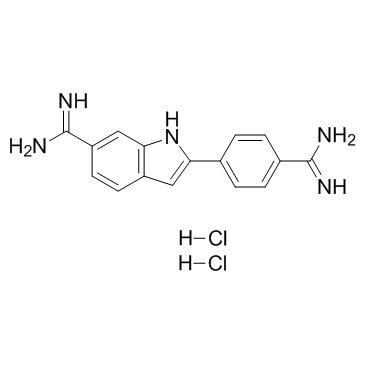4',6-二脒基-2-苯基吲哚二盐酸盐

4',6-二脒基-2-苯基吲哚二盐酸盐结构式

|
常用名 | 4',6-二脒基-2-苯基吲哚二盐酸盐 | 英文名 | 4',6-Diamidino-2-phenylindole dihydrochloride |
|---|---|---|---|---|
| CAS号 | 28718-90-3 | 分子量 | 350.246 | |
| 密度 | 1.41g/cm3 | 沸点 | 545.4ºC at 760mmHg | |
| 分子式 | C16H17Cl2N5 | 熔点 | >300°C (dec.) | |
| MSDS | 美版 | 闪点 | 283.6ºC |
|
Targeting glucose uptake with siRNA-based nanomedicine for cancer therapy.
Biomaterials 51 , 1-11, (2015) Targeting cancer metabolism is emerging as a successful strategy for cancer therapy. However, most of the marketed anti-metabolism drugs in cancer therapy do not distinguish normal cells from cancer cells, leading to severe side effects. In this study, we rep... |
|
|
Melatonin-mediated Bim up-regulation and cyclooxygenase-2 (COX-2) down-regulation enhances tunicamycin-induced apoptosis in MDA-MB-231 cells.
J. Pineal Res. 58(3) , 310-20, (2015) Melatonin is involved in many physiological functions, and it has differential effects on apoptosis in normal and cancer cells. However, the mechanism of its antitumor roles is not well understood. In this study, we show that melatonin enhances tunicamycin-in... |
|
|
The investigational Aurora kinase A inhibitor alisertib (MLN8237) induces cell cycle G2/M arrest, apoptosis, and autophagy via p38 MAPK and Akt/mTOR signaling pathways in human breast cancer cells.
Drug Des. Devel. Ther. 9 , 1627-52, (2015) Alisertib (ALS) is an investigational potent Aurora A kinase inhibitor currently undergoing clinical trials for the treatment of hematological and non-hematological malignancies. However, its antitumor activity has not been tested in human breast cancer. This... |
|
|
Transcriptional activation of Fsp27 by the liver-enriched transcription factor CREBH promotes lipid droplet growth and hepatic steatosis.
Hepatology 61(3) , 857-69, (2015) Fat-specific protein 27 (Fsp27) is a lipid droplet-associated protein that promotes lipid droplet (LD) growth and triglyceride (TG) storage in white adipocytes. Fsp27 is also highly expressed in the steatotic liver and contributes to TG accumulation. In this ... |
|
|
Insulin-like growth factor 1 increases apical fibronectin in blastocysts to increase blastocyst attachment to endometrial epithelial cells in vitro.
Hum. Reprod. 30(2) , 284-98, (2015) Does insulin-like growth factor 1 (IGF1) increase adhesion competency of blastocysts to increase attachment to uterine epithelial cells in vitro?IGF1 increases apical fibronectin on blastocysts to increase attachment and invasion in an in vitro model of impla... |
|
|
Co-ordinated brain and craniofacial development depend upon Patched1/XIAP regulation of cell survival.
Hum. Mol. Genet. 24(3) , 698-713, (2015) Congenital brain and craniofacial defects often occur together as a consequence of their developmental dependency on common progenitor tissue interactions and signaling pathways during embryogenesis. A classic example of this is perturbation of midline embryo... |
|
|
Progressive accumulation of activated ERK2 within highly stable ORF45-containing nuclear complexes promotes lytic gammaherpesvirus infection.
PLoS Pathog. 10(4) , e1004066, (2014) De novo infection with the gammaherpesvirus Rhesus monkey rhadinovirus (RRV), a close homolog of the human oncogenic pathogen, Kaposi's sarcoma-associated herpesvirus (KSHV), led to persistent activation of the MEK/ERK pathway and increasing nuclear accumulat... |
|
|
Drosophila tribbles antagonizes insulin signaling-mediated growth and metabolism via interactions with Akt kinase.
PLoS ONE 9(10) , e109530, (2014) Drosophila Tribbles (Trbl) is the founding member of the Trib family of kinase-like docking proteins that modulate cell signaling during proliferation, migration and growth. In a wing misexpression screen for Trbl interacting proteins, we identified the Ser/T... |
|
|
Blocking of the interaction between Wnt proteins and their co-receptors contributes to the anti-tumor effects of adenovirus-mediated DKK3 in glioblastoma.
Cancer Lett. 356(2 Pt B) , 496-505, (2014) The effect of the third member of the Dickkopf family (DKK3) in the Wnt pathway in glioblastoma remains unclear. We first demonstrated the non-specific interaction of Wnt3a and Wnt5a with the receptors LRP6 and ROR2 and the up-regulation of the Wnt pathway in... |
|
|
Insight into PreImplantation Factor (PIF*) mechanism for embryo protection and development: target oxidative stress and protein misfolding (PDI and HSP) through essential RIKP [corrected] binding site.
PLoS ONE 9(7) , e100263, (2014) Endogenous PIF, upon which embryo development is dependent, is secreted only by viable mammalian embryos, and absent in non-viable ones. Synthetic PIF (sPIF) administration promotes singly cultured embryos development and protects against their demise caused ... |